Multi-Channel MultiGenerational Customer Service- Gen X, Y, Millennials, Boomer, Silent Generation -Customer Experience
If you are in a business serving broad consumer markets, your customers are likely to span multiple generations – Gen X, Gen Y, millennials, boomers, silent generation and so on. A one-size-fits-all approach to customer engagement won’t work across these customer segments. Worse yet, you might miss large chunks of your market by not having a multi-generational customer engagement strategy.
It’s well-known that there are significant generational differences in lifestyles, service expectations, attitudes and technology use. For instance, while many of today’s toddlers use iPads, seniors often prefer basic, easy-to-use, cell phones. 92% of adults in the 18-29 age group use social versus 38% in the 65+ age group. Younger, social networking users expect faster service and prefer NOT to use the phone. If your whole operation is based on calls, you are not prepared for this next generation of customers. And to complicate matters, regardless of age group, many customers have also gone multichannel.
How can you plan for a multi-generational consumer engagement strategy for 2013 and beyond?
How do you design and deliver generation-tailored customer journeys so you can outperform your competition?
REGISTER for the upcoming webinar with the American Marketing Association, featuring Dr. Natalie Petouhoff, CEO of Social Business Builders, and Don Muchow, Sr. Product Marketing Manager foreGain. eGain, a leading provider of customer engagement software and is the gracious sponsor of the webinar.
Trends in Customer Experience Management and Social Media | CXMSummit Dallas
The customer experience management (CEM) market is on the brink of a major change that will revolutionize the way financial services companies learn from and interact with customers. It used to be enough for firms to just listen to customer-feedback data and act on it internally – but this is no longer the case. Financial services firms that want to not only survive, but thrive, have to take customer experience initiatives to the next level. That’s why I’m calling 2013 the “Year of Intelligent Customer Experience.” In 2013, the CEM industry will enable businesses to pull content from more sources, leverage more powerful analytics and intelligently use customer feedback to improve the business.
Historically, customer feedback has been pulled from multi-channel text – things like emails, surveys, chats and social media outlets. While this type of data has provided a wealth of information about the customer, there is still much more content out there that can be collected and analyzed. The future of the CEM industry will include sourcing all qualitative and structured content to get an even more detailed understanding of who the customer really is. This includes things like images, videos, audio files, unique transactions and online profiles, to name a few. Infusing traditional data with more qualitative, structured content will bring a deeper view into the person behind the customer.
Now that we have additional content, what are we going to do with it? The technology available in the CEM industry is strong, but it will only get stronger in terms of analytics. With more sophisticated analytics, we get a better understanding of sentiment and customer influence. Stronger analytics also enable us to separate the actionable from the non-actionable. Helping financial services firms make sense of what is irrelevant and what they need to focus on.
What is the next piece of the puzzle? Translating insights into actions is ultimately what really matters. Financial services organizations must not only listen to their consumers, but also treat them as valued stakeholders by engaging in a timely, open dialogue with them and then operationalizing the insights across all functions of the business. Once feedback is identified and categorized, it is channeled to the appropriate internal stakeholder – who can then interact directly with the consumer AND take the appropriate next steps within the business to take action to improve processes and make changes that will be positive for the customer and for the bottom line.


No comments:
Post a Comment